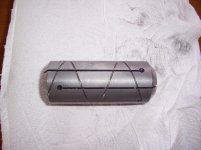captain-trumpet
Aluminum
- Joined
- Feb 22, 2016
Hi,
it`s reg lapping conrod races of an ole Harley.
I`ve got an adjustable external lap with a tapered mandrel chucked in the lathe, dia: 1.6" length ~ 4"
Jims Rod Lapping Set 9674�-36, Transfer Case - Amazon Canada
The races to lap have a length of approx .5"
Before I`m messing up a real rod I`m using a dummy of mild steel
I`m pushing the dummy onto the lap, adjust it that there`s still some play, put a few dabs of compound onto the lap (12 and 6 o`clock), shift the dummy back & forth and tighten the lap a bit more. Then I drip some thin oil onto the lap
Speed 160rpm, Silicone compound grit 280 (with oil)
My problem is that the dummy conrod is bellmouthing badly because the compound is building up on the right and left end of the lap. I`ve tried various methods to avoid this but nothing is satisfactory. I loosened the lap to have more play and being able to reach the end of the lap but this doesn`t work for me. Hmmmm.
Anyone can chime in with some wisdom?
Thanks for some comments
Rainer
EDit
I know that profesional wrenches are using honing machines but these shops screwed up my cylinder and heads and the ole fart I am looses patience rapidly. I know that there are good shops but I simply can 't find them and I`m not stingy at all. Sorry for the rant.
it`s reg lapping conrod races of an ole Harley.
I`ve got an adjustable external lap with a tapered mandrel chucked in the lathe, dia: 1.6" length ~ 4"
Jims Rod Lapping Set 9674�-36, Transfer Case - Amazon Canada
The races to lap have a length of approx .5"
Before I`m messing up a real rod I`m using a dummy of mild steel
I`m pushing the dummy onto the lap, adjust it that there`s still some play, put a few dabs of compound onto the lap (12 and 6 o`clock), shift the dummy back & forth and tighten the lap a bit more. Then I drip some thin oil onto the lap
Speed 160rpm, Silicone compound grit 280 (with oil)
My problem is that the dummy conrod is bellmouthing badly because the compound is building up on the right and left end of the lap. I`ve tried various methods to avoid this but nothing is satisfactory. I loosened the lap to have more play and being able to reach the end of the lap but this doesn`t work for me. Hmmmm.
Anyone can chime in with some wisdom?
Thanks for some comments
Rainer
EDit
I know that profesional wrenches are using honing machines but these shops screwed up my cylinder and heads and the ole fart I am looses patience rapidly. I know that there are good shops but I simply can 't find them and I`m not stingy at all. Sorry for the rant.




